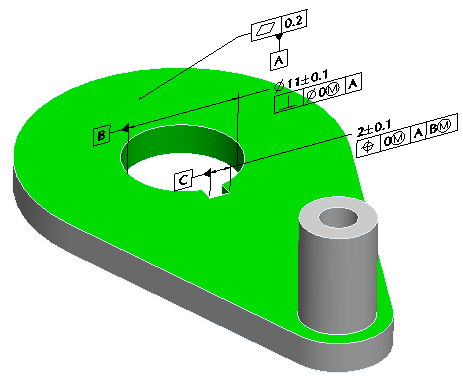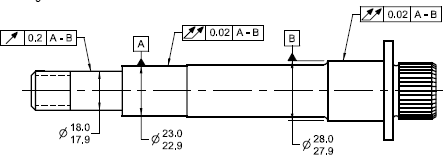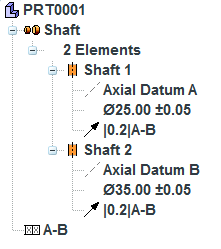Common Alternate Workflows
Change a Datum Reference of a DRF
After partially completing a model, it may be necessary to change one or more of the referenced datum features of a datum reference frame.

For example, in the model pictured above datum feature C is a slot feature. After partially completing the model you may want to reference the shaft feature as datum feature C. To do so, you should follow these steps:
1. Add the shaft feature and set it as a datum feature. It is automatically given the next available datum label value (e.g., 'D').
2. Reorder the shaft before datum feature C, the slot feature.
3. Edit the A|B|C DRF and select 'D' as the tertiary datum feature. All geometric tolerances that reference DRF are automatically updated.
4. Right-click on Planar Datum C and select Delete from the context menu.
5. Right-click on Axial Datum D and select Change Label from the context menu. Enter ‘C’ for the label and then click OK.
Define Self-Referential Datum Features
The figure below (from ASME Y14.5-2009) is an example of self-referential datum features. That is, datum features A and B are constrained by circular runout to datum A-B. Thus, this condition calls for a special work flow. Note that due to the fact that these features are self-referential, this case is only supported for a primary datum in GD&T Advisor.

To add a self-referential primary datum, you should follow the procedure below:
1. Add Feature and select two coaxial cylinders or two parallel planes, forming one of the following feature types:
◦ Cylindrical Group
◦ Cocylindrical Group
◦ Planar Group
◦ Coplanar Group
2. Specify the desired controls in the dashboard and then Accept. The feature is added to the model. The feature includes two sub-features.
3. Edit the first sub-feature and select the 'Datum Feature' and then Accept.
4. Edit the second sub-feature and select the 'Datum Feature' and then Accept.
5. Add DRF... and define the common datum (e.g., A-B).
6. Edit the first sub-feature and apply the applicable geometric tolerance, referencing the common datum, and then Accept.
7. Edit the second sub-feature and apply the applicable geometric tolerance, referencing the common datum, and then Accept.
After successfully completing the process, the Feature Tree will look like similar to the picture below.
